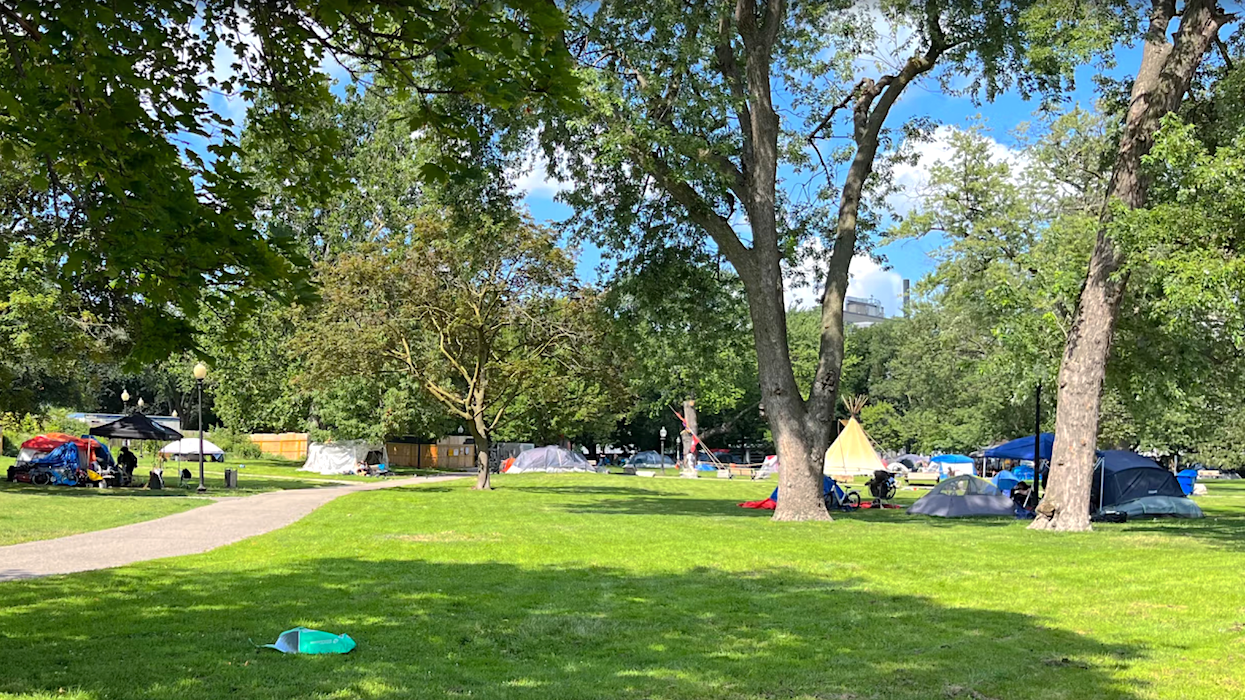It’s just after 5 p.m. on a late October evening in Toronto’s Allan Gardens park in the city’s Garden District neighbourhood. On the north side, children climb the play structure, soaking in the last of the daylight before dusk settles upon the sprawling park. Just southeast of there, the park’s infamous encampment – a grassy area that houses numerous tents and makeshift structures designed to provide shelter for their otherwise unhoused inhabitants – is peaceful.
Admittedly, this comes as a bit of a surprise as a first-timer to the park, which sits at Sherbourne and Gerrard Streets.
There’s quiet music playing outside of one structure; a woman stands in front of another with juice that she serves to anyone who wants it; another resident hangs clothes on a drying rack outside of a large, tarp-made shelter; a small fire burns from the grounds of an elaborate tipi-like structure beside a neat stack of firewood. Everyone is minding their business. Except for me, that is.
When I approach two residents at one tent, they tell me they have “nothing to say” about life in the encampment or the City of Toronto’s efforts to house its inhabitants. I ask them about Lynn, who I’d been told was the unofficial mayor of the encampment by an activist friend. “She’s gone,” says one of them. I immediately fear the worst. “She got housing,” she continues.
Lynn is just one of the numerous encampment residents who has been housed as of late. According to Councillor Chris Moise, who represents Toronto Central – which includes Allan Gardens – the encampment has been steadily shrinking during his year representing the ward as the City helps the park’s residents find other places to live.
“There’s always been a large number of unhoused people in my ward, mainly because 61% of social services that support people who are unhoused are in Toronto Central,” says Moise. “In my time as councillor, we’ve always had the largest encampment in the city. At one point, there were 89 structures. Through my work with City staff – who are truly heroes – we’ve been able to bring that down to 28 as of yesterday [October 20] and I’m told that 12 of those have housing plans.”
New structures aren’t allowed.
Moise said that he’s taking a “Dufferin Grove Model” approach with the Allan Gardens encampment. “When Toronto had an encampment in Dufferin Grove several years ago, City housing staff were brought onto the ground, who worked to find shelter or permanent housing for people,” says Moise. “So, rather than kicking them out and having them disperse somewhere else, with intention, we go in and work with the people living in Allan Gardens. I’ve brought a trailer into the park for the housing staff, who work Monday to Friday 9 a.m. to 5 p.m. to find housing for park residents. We also have three security teams to ensure there are no new encampments and to keep things safe.”
While the encampment was quiet and calm on that late afternoon, I’m told by both local residents and Councillor Moise that this isn’t always the case. A handful of neon vest-clad security officers strolling the park that evening offers a reminder that these moments of peace may indeed be fleeting, especially once night falls.
I approach two men – long-time friends Rob and Alain – who are sitting on a bench on a sidewalk that runs through the encampment, enjoying a few end-of-day brews and laughs. While they don’t live in the park, they are familiar with it and its residents. Both men – now in their mid-50s and early 60s – know very well what it’s like to be homeless in Toronto. They met decades ago, through local HIV support services (both are living with the virus) when they were both unhoused and addicted to drugs.
With long-term apartments, cell phones, and meaningful lives, they both now work closely with Toronto’s homeless community through employment at local community organizations, namely, helping those in drug-related crises. Coming full circle, they save countless lives of those experiencing overdoses. “I’ve lived in this park, and now we’re singing at the top of our lungs because we have places to live and want to help others who are unhoused,” says Rob. Both are vocal about the city’s homelessness crisis, which they, sadly, don’t see improving.
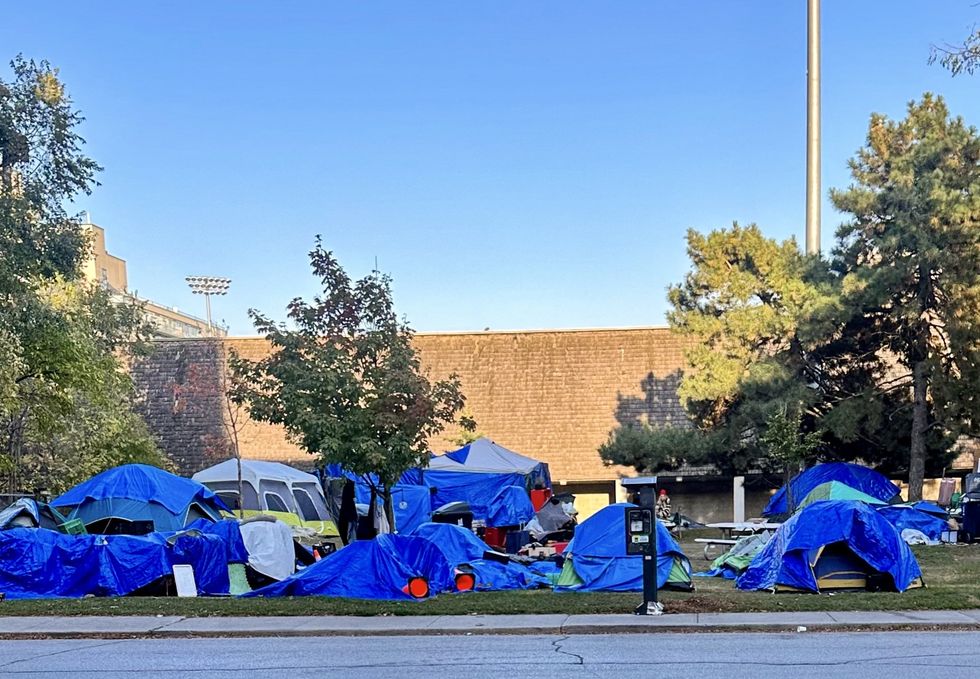
Encampments Are Back
While the dwindling number of structures at Allan Gardens is good news, the reality is that Toronto’s homeless problem is at crisis levels. City shelters now serve over 10,000 people per night. Many encampments – a common sight during the pandemic – are back throughout the city, as the issue becomes impossible to ignore (even for those who typically turn a blind eye).
Take Liberty Village’s Lamport Stadium. The encampment made headlines in 2021 when the forcible and dramatic eviction of residents by City of Toronto officials and the Toronto Police resulted in the arrest of dozens of residents and passionate cries from activists of the unhoused community. After years of being clear, the area is now filled with tents and other structures yet again. A little east of there, another encampment has taken over space in Clarence Square park, just outside of the Soho Hotel and Residences. In 2022, City of Toronto staff cleared the park, only to have some of its residents return that evening. Now, the encampment is back in full force. This past summer, encampments also became staples at Alexandra Park and along Rosedale Valley Road (to name a few).
“More people are experiencing homelessness than ever before in our city and the services, both emergency shelter and housing, are at a breaking point,” says Savhanna Wilson, Acting Executive Director of the Toronto Alliance to End Homelessness. “It’s becoming more difficult to adequately help people find the support and housing they need, and as the city becomes even more unaffordable, people have fewer options. The shelter system has long faced occupancy pressures due to the increasing lack of affordable housing in Toronto. The occupancy rate of the city’s shelter system is, on any given night, at almost 97%, and hundreds of people are denied beds night after night.”
Jonathan Miller, Chief Ministry Officer of Scott Mission, a men’s shelter on Spadina near College Street, says that Toronto’s homeless crisis has worsened in recent months and years. “We have a 71-bed men’s shelter and we are full every single night, seven days a week,” says Miller. “We are at maximum capacity and doing our best to serve the guys who are coming through our doors. I know the City of Toronto’s intake center is experiencing hundreds of calls each day.”
For those who do manage to secure a bed, Scott Mission tries to help clients access support and housing. “We are doing our best to provide a clean and safe shelter for those coming through our door, and I think they appreciate that,” says Miller. “But we also provide more than shelter; we provide opportunities for healthcare, counselling, and spiritual care – all of the things people need for a homeless transformation.”
The City says it's working to address the dire need, noting that Mayor Olivia Chow has secured additional shelter spaces as well as thousands of rent supplements to help move people into permanent, stable housing.
"The City’s shelter system is full," said Arianne Robinson, Mayor Chow's Press Secretary. "We are working to unlock additional spaces over the winter months, including more respite and advocating to the federal government for spaces. Historically, they have made their armouries available."
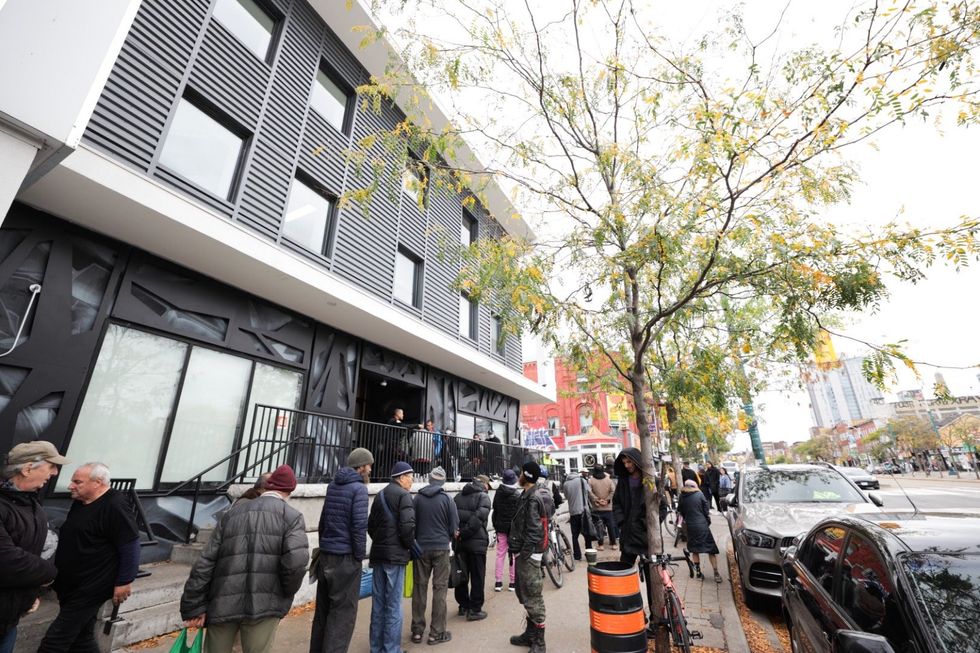
For Some, the Park is the Best Option
Capacity issues or not, however, for many, making a home – and community – on City of Toronto parkland is a more enticing option than a Toronto shelter. “You should hear the horror stories about the things that happen in some of these shelters,” says Rob. Both men shudder in unison.
“I’ve been in a shelter; it’s not a nice place to be sometimes and it may make your life worse,” says Alain. “You may end up in jail, provoked by someone with mental health issues, robbed, and your addictions may increase.” Alain recalls one shelter leaving him covered in bedbug bites. “Plus, they’re not stupid; they know how to make their spaces as comfortable as possible,” he continues, pointing to the structures behind him.
While many encampment residents undoubtedly appreciate being housed in affordable units – as opposed to the shelter system – Rob and Alain say that some simply don’t want it. “They know what they know,” explains Alain. “Some have mental health issues. Others like it here. This is like the five-star of Toronto encampments. Look around; there’s a real community here. People have fun.”
But that’s not to say that all encampments have the same vibe. “At [the encampment at] St. Stephen-in-the-Fields at Augusta and College – I’m up there every day – people are robbing one another, overdosing, and yelling at each other,” says Rob. “Allan Gardens is one of the cleanest and most respected encampments in the city.”
No Refuge for Refugees
The city’s growing number of newcomers is putting increased pressure on the problem of finding people safe places to live, says Miller. “We are seeing a shift in our demographics of our shelter population,” he says. “Now, about 50% are refugees or asylum-seekers. So, we’re just doing our best to serve those who come through our doors holistically.”
Moise too says that Toronto’s recent influx of refugees is compounding its homeless crisis. “A lot of people who are trying to enter the park or fill shelter beds are refugees from elsewhere – and that’s a problem on many levels,” says Moise. “People are coming in from war-torn countries – escaping death – and are ending up sleeping on our streets or in our shelters, and that’s not acceptable. Those in the shelter system have different needs than those who come here as refugees. Many shelter residents have mental health and addiction issues, and I think that exasperates the refugees who come here; it may do more harm than good to put those two groups together.”
Moise highlights how there are some 500 new refugees coming into Toronto each month and the city simply doesn’t have housing for most of these people. As few can forget, this summer, asylum seekers and refugees were infamously left with nowhere to go – sleeping on city sidewalks – upon arrival in Toronto.
“It’s percolating and the weather is changing, but the majority of these people are from Africa, according to records,” says Moise. “It’s one thing to have these people unhoused in the summer, but they’re not acclimatized to Canadian winters – living on the streets through them isn’t easy.” Moise says he’s addressed these concerns with City staff and his federal counterparts.
Earlier this month, some 100 refugees were bussed from Toronto to Windsor and Niagara Falls for shelter space.
"Right now, the City is facing an approximately $500M operating deficit for next year when it comes to operating shelters," Robinson said of Toronto. "The Mayor is working on securing a new deal for the city with the provincial government and is discussing cost sharing for shelters. The Mayor is also advocating federally for a sustainable plan for supporting refugees that includes a reception centre near the airport."
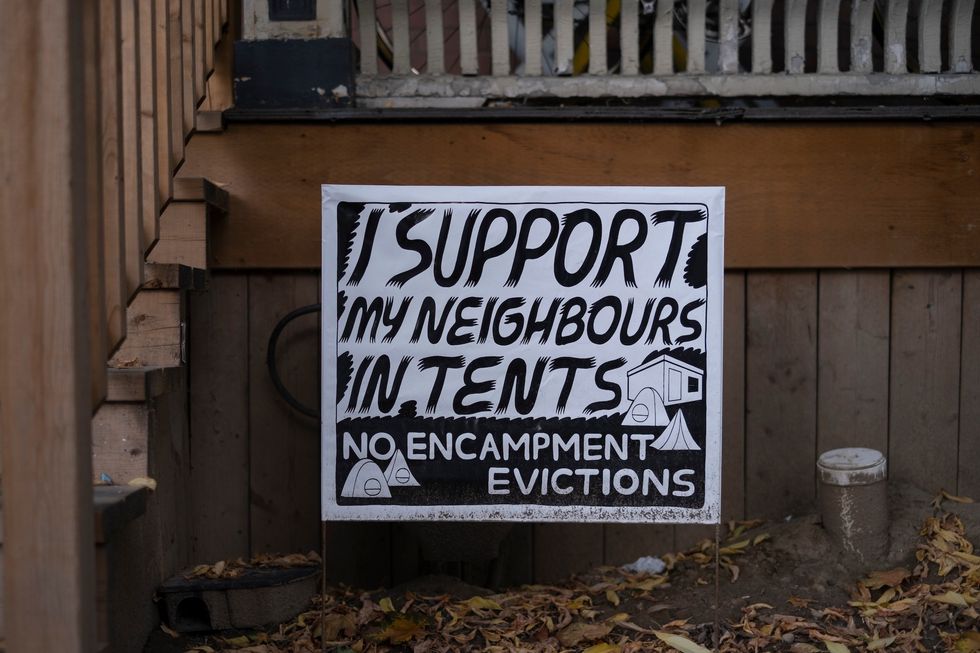
The Neighbours
Naturally, not everyone is pleased with the encampments in their local parks, especially in an increasingly dense city that’s relatively lacking in green space. Beyond taking up park space where kids could play or people could picnic, the main concern with encampments is public safety and security – including everything from confrontational run-ins with locals, to fire risks.
While he stresses that the surrounding neighbourhood is “patient and compassionate,” inevitably, Moise hears no shortage of pushback. “There have been incidences in the park where people have been yelled at, people have been threatened, and some park residents have aggressive dogs who are off-leash,” says Moise. “Something that’s still an issue is the music and amplified noises, especially at night. There is a seniors’ residence across the street on Sherbourne and they shouldn’t have to listen to that noise at night. Many seniors also don’t feel safe in the park.”
Meanwhile, in the downtown core’s tourist hub, many who call the Soho Condominiums home aren’t exactly thrilled with the encampment outside their door in Clarence Square. Ayman Hbeichi lives in the building and says that he and many of his neighbours are losing their patience with the encampment and its residents.
“They’re lighting fires, doing drugs, drinking, screaming, fighting, and stealing things off people’s balconies for the encampment,” says Hbeichi. “At night, it does get scary. It makes it a poor environment to live in, so a lot of people are moving out and leaving for places where this isn’t an issue.” Soho Condominiums now has two round-the-clock security guards – there used to be just one, says Hbeichi. “This is also a luxury hotel right next to the Rogers Centre,” says Hbeichi. “But this encampment is the first thing that some tourists see.”
Wilson, however, says that basic human rights – even if at the expense of the patience of local residents – should come first. “While we are having conversations about safety and use of public land, it is critical to recognize the violation of rights that people living in encampments are facing in Toronto,” says Wilson. “Being denied the right to access housing is the most significant concern that encampments pose to our communities, and the lack of access to safe, affordable housing forces people who are already marginalized into even more precarious places.”
The Role of Toronto’s Housing Market
The bottom line is that Toronto’s supply of affordable and supportive housing units is no match for the demand. And the state of the city’s housing market isn’t exactly helping the situation.
“Some of it is the housing crisis, cost of living, and the inability to find affordable places to live,” says Miller of factors that contribute to homelessness in Scott Mission clients. “We’ve all experienced the price crunch on inflation. It’s hard to find a place to live in Toronto, even if you have a job and are making decent money. We’ve got guys in our shelter who are working part-time, they’re making minimum wage jobs and they simply can’t make first and last month’s rent, even if there were affordable places available. It’s not that they don’t want to, they just can’t take those steps.”
Giacomo Ladas, Communications Manager at rentals.ca, doesn’t necessarily think that Toronto’s pricey rental market is a main driving culprit when it comes to the city’s homeless crisis – rather, the problem is the unavailability of deeply affordable housing. “There is a serious lack of supply for both rentals and housing,” says Ladas. “Prices are extremely high, the economy isn't in the best shape, and our population keeps growing at an all-time rate. Many factors can contribute to the homelessness crisis. My assumption is that, while the rental market is in a rocky place right now, it wouldn't necessarily be a direct contributor to the homelessness crisis.”
Ladas points to the changing demographic of Toronto renters. “I think what's interesting to note is that one-third of total households in Canada are renters — five million households — and it's growing twice as fast as home ownership,” says Ladas. “We have a lot of renters and they are different from what we typically think. Renters are no longer just low-income individuals but rather families with two incomes in many cases. Home ownership is a pipedream for many and therefore renting has become the only option.”
Housing market and affordable housing aside, Rob points to drug addiction as a major contributor to homelessness – he sees it daily first-hand. Of course, the correlation between addiction and homelessness is a well-known one. Other mental health issues are right up there as well. “In my experience as a homeless drug addict, it’s not just one thing that contributes to homelessness,” says Alain. “There’s not one problem or one solution.”
What Should Be Done?
As encampments remain illegal, the City says in a statement on its website that it will enforce the clearing of encampments after exhausting all tools and options available to help move people to safer indoor spaces and in the event of serious health and safety risks that require immediate action.
What we won’t see is the violent and forceful removal of encampment residents by Toronto Police that we saw during the pandemic in places like Trinity Bellwoods Park and Lamport Stadium – something the City’s ombudsman Kwame Addo found demonstrated “significant unfairness” in a report released in March. With it came a set of recommendations that the City should follow when clearing a camp, including mental health support.
“Homelessness is a violation of the human right to housing,” says Wilson. “Encampments embody this violation and any response taken must begin with a human rights approach. This is the foundation for progressive fulfillment of the right for all Torontonians, committed to by Toronto City Council in the updated Housing Charter and the Housing TO Action Plan.”
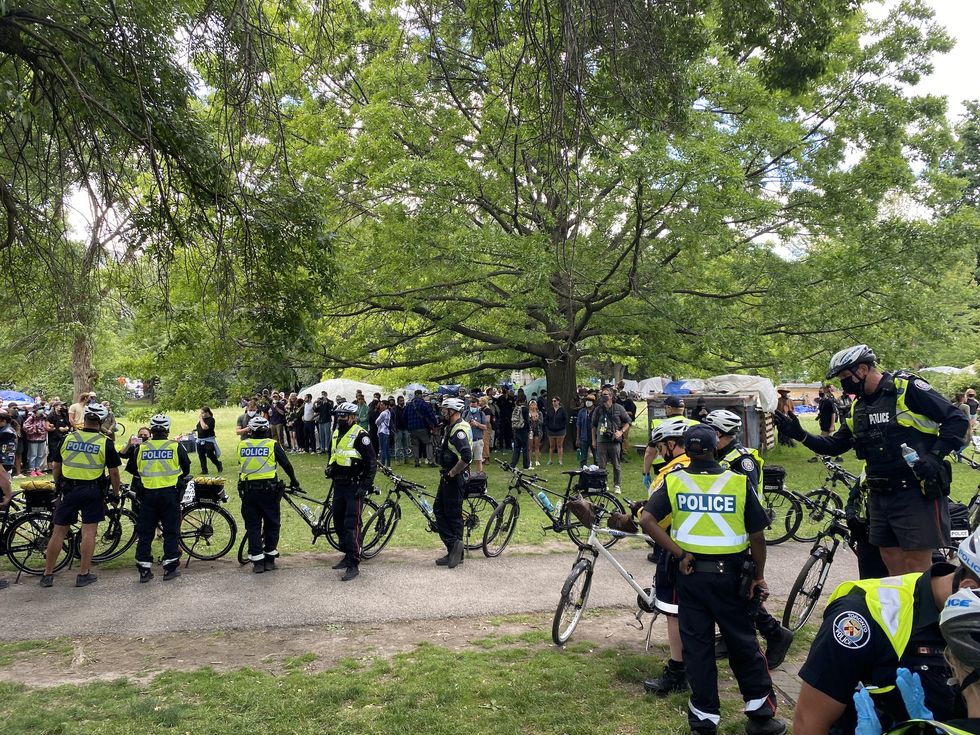
Wilson says that the solution to the growth of encampments is to increase investments in the delivery of comprehensive Housing First options for people who are living in them. “This includes developing new affordable and deeply affordable housing options and increasing allocations of critical housing allowances and rent subsidies that are targeted directly for people who are experiencing homelessness,” says Wilson. “These increased fund allocations must be sufficiently deep enough to create immediate access to rental housing for people experiencing homelessness and coupled with strategies to make that housing available urgently.”
Plain and simple, Miller too says the most helpful move forward would be more affordable housing opportunities for people. “The waiting lists are way too long and unsustainable,” says Miller. “So, if the City and others could find ways to open up affordable housing for people, that would help. Some of that’s funding and some of it is finding creative solutions.” Ideas that have been tossed around include everything from enticing local business owners to rent out small spaces to converting underused office buildings into affordable housing.
Wilson calls on the non-profit sector. “While urgent and immediate changes need to be made to mitigate the current emergency, we must also enhance the capacity for the non-profit sector to introduce and expand models of supportive, affordable, and deeply affordable housing, and work to de-commodify affordable housing units to provide long-term change,” says Wilson. “This must go beyond increasing housing supply to also include stronger regulation of development and address, head on, the challenge of unfair competition for housing that has only been exacerbated by treating housing as a real estate investment, and not as a human right.”
Wilson says there needs to be stronger collaboration from all orders of government to ensure that the needs of the city’s most marginalized and economically disenfranchised are met. “A dedicated plan to reduce and end homelessness is needed, and all orders of government must come to the table together with sector experts, people with lived experience, and advocates to co-design a strategy for reducing homelessness, with clear targets for housing outcomes month over month,” she says.
As for Moise, he’s asked for a regional strategy on the unhoused and wants to encourage a dialogue with other municipalities. “A lot of people come to Toronto because that’s where the social services are,” he explains. “Places like Peterborough or Windsor haven’t historically had a lot of shelters or addiction services. So, many people come from out of town with a suitcase. We have to make sure that people are safe and taken care of within their communities. Toronto has to work in silos with these places.” People are more successful when taken care of in their communities, close to friends and family and familiarity, highlights Moise.
In the meantime, his focus remains on transitioning the residents of Allan Gardens. “Our model is working, and people who were housed in the park haven’t returned,” says Moise. While this is just a small win in combating the city’s overall crisis, the best we can hope for is more stories like those of Rob and Alain.
